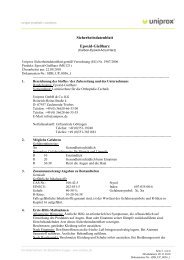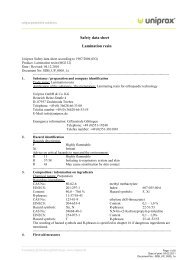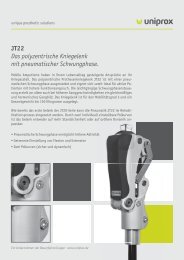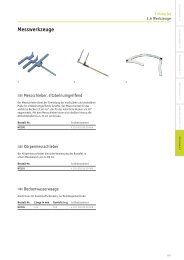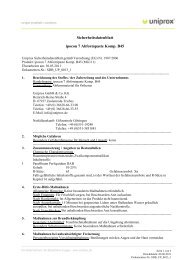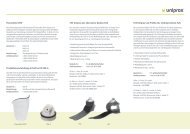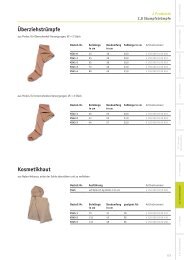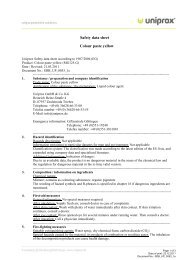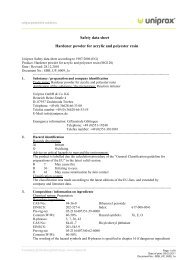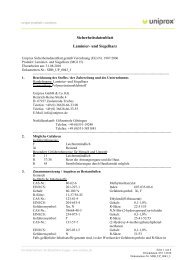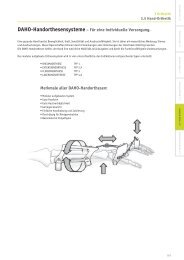Safety data sheet MG115 Lamination ans sealing resin ... - uniprox
Safety data sheet MG115 Lamination ans sealing resin ... - uniprox
Safety data sheet MG115 Lamination ans sealing resin ... - uniprox
You also want an ePaper? Increase the reach of your titles
YUMPU automatically turns print PDFs into web optimized ePapers that Google loves.
<strong>Safety</strong> <strong>data</strong> <strong>sheet</strong><strong>Lamination</strong> and <strong>sealing</strong> <strong>resin</strong>Uniprox <strong>Safety</strong> <strong>data</strong> <strong>sheet</strong> according to 1907/2006 (EG)Product: <strong>Lamination</strong> and <strong>sealing</strong> <strong>resin</strong> (<strong>MG115</strong>)Date / Revised: 27.12.2010Document No.: SDB_UP_0043_1e------------------------------------------------------------------------------------------------------------------------1. Substance / preparation and company identificationTrade name: <strong>Lamination</strong> and <strong>sealing</strong> <strong>resin</strong>Application of the substance / the preparation: Polymerising adhesiveUniprox GmbH & Co. KGHeinrich Heine-Straße 4D- 07937 Zeulenroda TriebesTelephone: +49 (0) 36628-66-33 00Telefax number +49 (0) 36628-66-33-55E-Mail: info@<strong>uniprox</strong>.deEmergency information: Giftzentrale GöttingenTelephone: +49 (0)551-19240Telefax number: +49 (0)551-3831881--------------------------------------------------------------------------------------------------------------------------2. Hazard identificationHazards description:FHighly flammableXiIrritantAdvice on critical hazards to man and the environment:R 11 Highly flammableR 37/38 Irritating to respiratory system and skinR 43 May cause sensitisation by skin contact--------------------------------------------------------------------------------------------------------------------------3. Composition / information on ingredientsChemical nature: PreparationHazardous ingredients:CAS No.: 80-62-6 methyl methacrylateEINECS: 201-297-1 Index: 607-035-00-6Content: 60,0 – 100,0 % Hazard symbols: F, XiR-phrases: 11-37/38-43CAS No.: 123-81-9 ethylene di(S-thioacetate)EINECS: 204-653-4 Content: 0,1 – 1,0 %Hazard symbols: Xn, N R-phrases: 22-51/53CAS No.: 38668-48-3 N,N-bis-(2-hydroxypropyl)-p-toluidineEINECS: 254-075-1 Content 0,1 – 1,0%Hazard symbols: T R-phrases: 25-52/53CAS-Nr.: 131-57-7 (2-Hydroxy-4-methoxyphenyl)phenylmethanoneEINECS: 205-031-5 Content: 0,1-1,0%Hazard symbols: N R-phrases: 51/53Page 1 of 6Date of print: 04.02.2011Document No.: SDB_UP_0043_1e
The wording of hazard symbols and R-phrases is specified in chapter 16 if dangerous ingredients arementioned.--------------------------------------------------------------------------------------------------------------------------4. First-aid measuresGeneral information: Medical treatment is necessary if symptoms occur which are obviously causedby skin or eye contact with the product or by inhalation of its vapours. Remove soiled, soakedclothing immediately.After inhalation: Move subject to fresh air and keep him calm. See a physician.After skin contact: Wash off immediately with soap and water. If skin irritation occurs consult aphysician.After eye contact: Keeping the eyelids apart flush thoroughly with water immediately. If irritationpersists, contact a physician.After ingestion: Do not induce vomiting. Call a physician immediately.-------------------------------------------------------------------------------------------------------------------------5. Fire-fighting measuresSuitable extinguishing agents: Foam, dry chemical, carbon dioxideUnsuitable extinguishing agents for safety reasons: WaterSpecial protective equipment for fire fighting: Wear self-contained breathing apparatus.-------------------------------------------------------------------------------------------------------------------------6. Accidental release measuresPersonal precautions: Keep away from ignition sources. Take care for adequate ventilation. Usepersonal protective clothing. Use breathing apparatus if exposed to vapours / dust.Environmental precautions: Prevent product from getting into drains / surface water / groundwater.Methods for cleaning up: Larger quantities: Remove mechanically (by pumping). Use explosionproofequipment! Smaller quantities and / or residues: Contain with absorbent material (e.g. sand,diatomaceous earth, acid absorbent, universal absorbent or sawdust). Dispose of in accordance withregulations.--------------------------------------------------------------------------------------------------------------------------7. Handling and storageHandling:Instruction on safe handling: Ensure the area is well ventilated. Keep container tightly closed.Information on fire and explosion protection: Keep away from sources of ignition --- no smoking.Take precautionary measures against static discharges in the event of fire; cool the endangeredcontainers with water. When heated above the flash point and /or during spraying (atomizing),ignitable mixtures may form in air. Use explosion-proof equipment only.Storage:Requirements for storage areas and containers: Keep only in the original container at a temperaturenot exceeding 25°C. Protect from light. Fill the container by approximately 90% only as oxygen (air)is required for stabilisation. With large storage containers make sure the oxygen (air) supply issufficient to ensure stability.-------------------------------------------------------------------------------------------------------------------------8. Exposure controls and personal protectionComponents with workplace control parameters:CAS-No.: 80-62-6methyl methacrylateWEL-TWA:55 ppmWEL-TWA:208 mg/m³WEL-STEL:100 ppmWEL-STEL:416 mg/m³WEL (AGW).50 ml/m³ = ppmWEL (AGW):210 mg/m³Occupupational exposure controls: For monitoring procedures refer to for instance “EmpfohleneAnalyseverfahren für Arbeitsplatzmessung” Schriftenreihe der Bundes<strong>ans</strong>talt für Arbeitsschutz and“NIOSH Manual of Analytical Methods”, National Institute for Occupational <strong>Safety</strong> and HealthPage 2 of 6Date of print: 04.02.2011Document No.: SDB_UP_0043_1e
Personal protective equipmentGeneral protective and hygienic measures: Do not inhale vapours. Avoid contact with eyes and skin.Hygiene measures: Store work clothing separately. Remove soiled or soaked clothing immediately.Follow the usual good standards of occupational hygiene. Clean skin thoroughly after work; applyskin cream.Respiratory protection: Breathing apparatus in case of high concentrations, short term: filterappliance, filter AHand protection: Butyl rubber gloves (0,7 mm), Breakthrough time approx. 60 min (EN 374)In practice, due to variable exposure conditions, this information can only be an aid to orientation forthe selection of a suitable chemical protection glove. In particular, this information does notsubstitute suitability tests by the end of the user.General information: Gloves should be replaced regularly, especially after extended contact with theproduct. For each work-place a suitable glove type has to be selected.Eye protection: Tightly fitting gogglesBody protection: On handling of larger quantities: face mask, chemical-resistant boots and apron--------------------------------------------------------------------------------------------------------------------------9. Physical and chemical propertiesForm:liquidColour:violetOdour:ester-likeBoiling point: 100,5°C (methyl methacrylate)Flash point: 10°C (methyl methacrylate)Ignition temperature: 430°C (methyl methacrylate)Spontaneous ignition: not determinedLower explosion limit: 2,1 %(V) (methyl methacrylate)Upper explosion limit: 12,5 %(V) (methyl methacrylate)Vapour pressure: 40 hPa at 20°CDensity: approx. 1,02 g/cm³ at 20°CRelative vapour density: 5000 mg/kgRelated to substance: methyl methacrylateLD50 rat, OECD172 mg/kgRelated to substance: N,N-bis-(2-hydroxypropyl)-p-toluidineAcute inhalational toxicity:Low toxicity by inhalationLC50/4h rat29,8 mg/lRelated to substance: methyl methacrylateAcute dermal toxicity:Practically non toxic in contact with skin.LD50 rabbit>5000 mg/kgRelated to substance: methyl methacrylateIrritant Effect on the skin: Contact with skin may cause irritations.Page 3 of 6Date of print: 04.02.2011Document No.: SDB_UP_0043_1e
Irritant effects on the eyes: Contact with eyes may cause irritation.Sensitisation:In sensitisation tests on guinea pigs with and without adjuvant, both positive and negative resultswere found. In hum<strong>ans</strong> various types of allergic reactions have been observes (symptoms: headache,eye irritations and skin affections).Related to substance: methyl methacrylateToxicity on repeated administration:Dose ad which no adverse effects were observed (NOAEL). At higher doses adverse effects wereobserved.rat, inhalation, 2a ,0, 25, 100, 400ppmNOAEL 25 ppmFindings: Damage to mucous membranes in the nose at 400 ppmRelated to substance: methyl methacrylaterat, in drinking water, 2a, 0, 6/7, 60/70, 2000ppmNOAEL 2000 ppmFindings: no toxic effectsRelated to substance: methyl methacrylateMutagenicity:Positive as well as negative results in in vitro mutagenicity/genotoxicity tests.No experimental indication of genotoxicity in vivo available.In summary not mutagenic according to internationally accepted criteria.Related to substance: methyl methacrylateCarcinogenicity:Non-carcinogenic in inhalation and feeding studies carried out on rats, mice and dogs.Related to substance: methyl methacrylateReprotoxicity / teratogenicity:No indications of toxic effects were observed in reproduction studies in animals.Related to substance: methyl methacrylateGeneral information’s:There are no toxicological <strong>data</strong> available for the product as such. Avoid contact with the skin,eyes and inhalation of the product vapours.--------------------------------------------------------------------------------------------------------------------------12. Ecological informationPersistence and degradabilityBiodegradabilityBiodegradable (monomer constituent)Ecotoxicological effectFish toxicity:LC50 Oncorhynchus mykiss, rainbow trout, OECD 203flow through GLP, 96h79 mg/lRelated to substance: methyl methacrylateDaphnia toxicity:EC50 Daphnia magna, OECD 202, flow trough, 48 h 69 mg/lRelated to substance: methyl methacrylateNOEC Daphnia magna, OECD 202 part 2, flow trough, 21d 37 mg/lRelated to substance: methyl methacrylateAlgae toxicity:EC3 Scenedesmus quadricauda, DIN 38412 section 9, 8d 37 mg/lRelated to substance: methyl methacrylateBacteria toxicity:ECO Pseudomonas puida100 mg/lRelated to substance: methyl methacrylateGeneral information’s:Do not allow to enter soil, waterways or waste water--------------------------------------------------------------------------------------------------------------------------Page 4 of 6Date of print: 04.02.2011Document No.: SDB_UP_0043_1e
13. Disposal considerationsProduct:Waste is hazardous and therefore particularly to be kept under surveillance. It must be disposed of inaccordance with the regulations after consultation of the competent local authorities and disposalcompany in a suitable and licensed facility.European waste catalogue: 08 04 09Waste from the manufacture, formulation, supply and use (MFSU) of adhesives and sealants(including waterproofing products) – waste adhesives and sealants containing organic solvents orother dangerous substance. Always check the given waste codes according to the actual conditions ofmanufacturing, formulation or use in your facilities.Uncleanness packaging:Contaminated packaging should be emptied optimally and after appropriate professional cle<strong>ans</strong>ingmay be taken for reuse. Packaging that cannot be cleaned should be disposed of professionally.Uncontaminated packaging may be taken for recycling.--------------------------------------------------------------------------------------------------------------------------14. Tr<strong>ans</strong>port informationLand tr<strong>ans</strong>port ADR (cross-border):ADR/GGVS: 3UN-Number: 1133Packaging group: IIILabel: 3Tr<strong>ans</strong>port category: 3Tunnel restriction code: D/EDescription of goods: 1133 ADHESIVES (containing: methyl methacrylate)ADR:Special provision 640HRID/GGVE: See ADRMaritime tr<strong>ans</strong>port IMDG:IMDG Class: 3UN-Number: 1133Packaging group: IIEMS Number: F-E, S-DMarine pollutant:Packed (+/0): 0Proper shipping name: 1133 ADHESIVES (containing: methyl methacrylate)Air tr<strong>ans</strong>port ICAO-TI and IATA-DGR:ICAO/IATA Class: 3UN/ID Number: 1133Label: 3Packaging group: IIProper shipping name: 1133 ADHESIVES (containing: methyl methacrylate).--------------------------------------------------------------------------------------------------------------------------15. Regulatory informationRegulations of the European union (Labelling) / National legislation/Regulations:Directive 1999/45/EEC ('Preparation Directive): requires labellingHazardous component(s) for labelling:Contains:methyl methacrylateHazard symbol(s):FHighly flammableXiIrritantR-phrase(s)R 11 Highly flammableR 37/38 Irritating to respiratory system and skin.R 43 May cause sensitization by skin contactPage 5 of 6Date of print: 04.02.2011Document No.: SDB_UP_0043_1e



